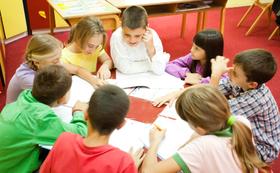Serving 923 students in grades 6-8, Cleveland Middle School ranks in the top 20% of all schools in North Carolina for overall test scores (math proficiency is top 30%, and reading proficiency is top 30%).
The percentage of students achieving proficiency in math is 66% (which is higher than the North Carolina state average of 51%). The percentage of students achieving proficiency in reading/language arts is 65% (which is higher than the North Carolina state average of 50%).
The student-teacher ratio of 18:1 is higher than the North Carolina state level of 15:1.
Minority enrollment is 51% of the student body (majority Black and Hispanic), which is lower than the North Carolina state average of 57% (majority Black).
Quick Facts (2025-26)
- Grades: 6-8
- Enrollment: 923 students
- Student-Teacher Ratio: 18:1
- Minority Enrollment: 51%
- Overall Testing Rank: Top 20% in NC
- Math Proficiency: 66% (Top 30%)
- Reading Proficiency: 65% (Top 20%)
- Science Proficiency: 89% (Top 5%)
- Source: National Center for Education Statistics (NCES), NC Dept. of Education
Top Rankings
Cleveland Middle School ranks among the top 20% of public schools in North Carolina for:
Category
Attribute
Overall Rank
Reading/Language Arts Proficiency
Science Proficiency
School Overview
Cleveland Middle School's student population of 923 students has stayed relatively flat over five school years.
The teacher population of 50 teachers has declined by 7% over five school years.
Grades Offered
Grades 6-8
(No virtual instruction)
(No virtual instruction)
Total Students
923 students
Gender %
Total Classroom Teachers
50 teachers
Year Founded
1905
Last Day of School
Mon. May 25, 2026
Campus Size
50 acres
School Rankings
Cleveland Middle School ranks within the top 20% of all 2,617 schools in North Carolina (based off of combined math and reading proficiency testing data).
The diversity score of Cleveland Middle School is 0.67, which is less than the diversity score at state average of 0.71. The school's diversity has stayed relatively flat over five school years.
Overall Testing Rank
#508 out of 2617 schools
(Top 20%)
(Top 20%)
Math Test Scores (% Proficient)
(21-22)66%
51%
Reading/Language Arts Test Scores (% Proficient)
65%
50%
Science Test Scores (% Proficient)
89%
63%
Student-Teacher Ratio
18:1
15:1
American Indian
n/a
1%
Asian
2%
4%
Hispanic
21%
21%
Black
22%
25%
White
49%
43%
Hawaiian
n/a
n/a
Two or more races
6%
6%
All Ethnic Groups
Participates in the National School Lunch Program (NSLP)
Yes
Eligible for Free Lunch
100%
68%
Eligible for Reduced Lunch
4%
3%
School Statewide Testing
School District Name
Source: National Center for Education Statistics (NCES), NC Dept. of Education
School Notes
- School Mascot: Wild Boars
Profile last updated: 02/09/2025
Frequently Asked Questions
What is Cleveland Middle School's ranking?
Cleveland Middle School is ranked #508 out of 2,617 schools, which ranks it among the top 20% of public schools in North Carolina.
What schools are Cleveland Middle School often compared to?
Cleveland Middle Schoolis often viewed alongside schools like Riverwood Middle School by visitors of our site.
What percent of students have achieved state testing proficiency in math and reading?
66% of students have achieved math proficiency (compared to the 51% NC state average), while 65% of students have achieved reading proficiency (compared to the 50% NC state average).
How many students attend Cleveland Middle School?
923 students attend Cleveland Middle School.
What is the racial composition of the student body?
49% of Cleveland Middle School students are White, 22% of students are Black, 21% of students are Hispanic, 6% of students are Two or more races, and 2% of students are Asian.
What is the student-teacher ratio of Cleveland Middle School?
Cleveland Middle School has a student ration of 18:1, which is higher than the North Carolina state average of 15:1.
What grades does Cleveland Middle School offer ?
Cleveland Middle School offers enrollment in grades 6-8 (No virtual instruction).
What school district is Cleveland Middle School part of?
Cleveland Middle School is part of Johnston County Public Schools.
School Reviews
2 10/10/2025
I rank this school a 3 out of 10. Academically they teach for tests and push retesting to keep their ratings falsely high. The school district/school policies are not consistently upheld and extreme measures of discipline are given for minor infractions. In my opinion bulling by the school staff is the reason my child has gone from excelling in learning to having panic attacks and moderate to failing grades. No amount of parent involvement other than for fundraising is encouraged and administration will only provide policy and excuses when confronted about the way they handle any situation. There is a limited number of sports and cheerleading offered. Please consider other school options if you plan on moving the Johnston County, NC. I wish we had now taken our chances and gone a wake county school.
Review Cleveland Middle School. Reviews should be a few sentences in length. Please include any comments on:
- Quality of academic programs, teachers, and facilities
- Availability of music, art, sports and other extracurricular activities
Recent Articles

School Vouchers: Updated Pros and Cons (2025 Review)
Comprehensive 2025 analysis of school vouchers, weighing benefits and challenges for families, funding, outcomes, and policy directions.

Benefits and Drawbacks of Homework in 2025
Explore updated 2025 insights on homework’s benefits, drawbacks, mental health impact, best practices, and policy trends in U.S. public schools.

Charter Schools vs Public Schools 2025: Key Differences & Trends
Explore updated 2025 insights comparing charter schools vs public schools, enrollment, academic outcomes, funding, and real-world examples for families and educators.





